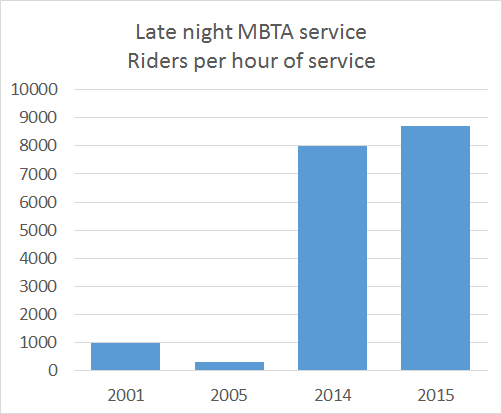Surprising no one, the T cut late night service. Why? Because it cost money to operate (like any transit, but still). Because it wasn’t as efficient as rush hour passengers. While we don’t have all of the T’s data, we have some, so let’s look at it, shall we?
1. Passengers per hour on a partial system
According to the T via BostInno, the late night service carried 16,000 passengers when it ran until 2:30 (two hours of service) and 13,000 when it ran until 2:00 (90 minutes of service). Per hour, this means that the system carried 8000 and then 8700 passengers per hour. From the same post, there are 72,000 passengers during a peak commuting hour, 33,000 during a weekend afternoon, and 14,000 during the first hour of service in the morning.
Of course, these numbers are misleading, because while all routes run at rush hour, and most run early in the morning and during the weekend, fewer than a dozen bus routes run during the late nights, accounting for 300,000 daily passengers. So the universe of people who could use late night service is only about 70% of the total passengers (and this doesn’t account for reduced train boardings because passengers can’t transfer to a bus that doesn’t run). If only the late night routes ran between 5 and 6 a.m., we’d expect ridership to be just 9800 per hour, or about what late night ridership is. (And if you were to, say, look at a Saturday morning, it’s probably significantly lower.)
So by that logic, should we cut service at any time it is less than, say, 10,000 per hour? Maybe we shouldn’t run service before 6:30 on weekdays? Or before 10 on Sundays?
2. Cost effectiveness compared to rush hours
The T has claimed time and again that late night service isn’t cost effective, because it costs more than average. I’m not making this up: the T’s chief administrator said exactly this. But that’s not how averages work, especially with a peak-demand service like transit. It is always going to cost less per passenger to provide transit at high use times, and more at low use times. The idea is where you want to draw the line. The T paints the picture of this money-hemorrhaging service during late night hours, but only compares it against the overall average, which includes times when the T makes money (yes, during rush hour, the T makes money). A much fairer comparison would be to compare it to, say, all weekend service, or 10 p.m. to end of service on weeknights. Those times probably have similar cost effectiveness. If you compare it to 8:15 a.m., it’s extraordinarily inefficient. But if we had the numbers to compare it to, say, 10:30 p.m. on a Tuesday, or 9:00 a.m. on a Saturday, I bet it would hold its own.
It should be notable that the stated cost for late night service went up from $7.68 in 2014 to $13.39 in 2015, a 74% increase, even as, when measured by passengers per hour, it became more efficient. This might be some more dubious—I mean, innovative—accounting from the FMCB, and it wouldn’t be the first time I’ve accused them of that.
3. Defining success (moving the goalposts)
When the Night Owl service ended in 2005, it was a failure: at the end, only 655 passengers were using it nightly over two hours: 327 per hour. (It should be noted that in 2004, the subsidy for the service was higher than the 2013-2015 service.) The current iteration of the service carried 13,000 passengers in just 90 minutes, averaging 8667 per hour, 26.5 times as many. The service didn’t make money, but it was never going to. The beancounters saw the numbers, and declared it a failure. It’s too bad, because based on its ridership, it was a success.
I think that a lot of the work that the fiscal and management control board is doing is worthwhile, and there are certainly places in the MBTA budget where efficiencies can be found to reduce costs. (I’ve, uh, strongly suggested some on this page.) Yet when they want to cut service, they have a knack for massaging numbers to fit their narrative, even if the bigger picture doesn’t support it. This makes the whole operation much less credible: decisions made with poor data should be anathema to their process.
Unfortunately, they’re not.


Thanks for the insights.
MBTA can do what it wants.
Unfortunate.
I feel like this points to the need to advocate for strong performance metrics when introducing pilot services.
I would like to see an independent analysis of the costs and opportunities associated with true late night service (i.e., operated 1 a.m. to 5 a.m. seven nights per week). I'm not too upset that this iteration is dying because it was a half-baked proposal to begin with and seemed designed more to cater to late night revelers than to the needs of third-shift workers. What is needed is an analysis that looks at where the need is greatest and how to best meet those needs, even if the system used buses paralleling the rapid transit routes to start with.
What 3rd shift workers start or end their shifts between 1 and 5 a.m.? Yes there maybe a handful of bar or restaurant employees that may use the late night service, but not enough to justify the service. As for buses paralleling the RTL lines, that was total failure when tried in the mid-2000's. Shut it down and keep it shut down. Score a rare win for the taxpayers.
Try half the shifts at the airport. Next question.